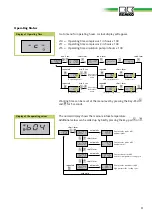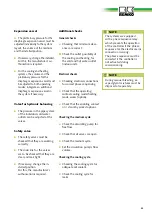
Installation instructions for qualified personnel
■
To install the system it is impor-
tant to follow the installation
instructions for both the chiller
and the chilled water system
(indoor system) or heating
system when installing the
entire system.
■
The indoor system and the
chiller work independently. A
connection between the two is
not necessary.
■
Transport the unit in its original
packaging as close as possible
to the installation location to
avoid damage.
■
The units may only be moved
upright (installed position) using
appropriate transport equipment
(Figure 1)
.
Secure against tipping!
■
The unit must be kept upright
when transporting to a higher
elevation
(Figure 2)
.
■
Check that the packaged con-
tents are complete and inspect
the system for any visible signs
of transport damage.
Report any damage immediate-
ly to your contract partner and
the shipping company.
■
Select an installation location
with free air movement both
for the inlet and outlet. See
section “Minimum clearances”.
■
Do not install the unit in the
immediate vicinity of devices
with intensive thermal radia-
tion, this will reduce the cooling
capacity.
■
Lift the unit only at intended
lifting points. Never stress the
medium or refrigerant pipings.
■
The medium connection lines,
valves and connections must be
insulated against vapour
density. If necessary, also insu-
late the condensate line (only
units with HP-function). In dual
systems with cooling and
heating modes, the
requirements of the current or
other local law (EnEV) are to be
complied with.
■
Seal off open lines against dirt
and never kink or crimp the
lines.
■
Avoid unnecessary bending.
■
Establish all electrical connec-
tions connections in accordance
with the relevant DIN- and VDE
or other local standards.
■
Always fasten electric wiring
properly to the terminals,
otherwise there is a risk of fire.
■
Comply with all regulations
governing structural and build-
ing requirements and conditions
with regard to the installation
site.
■
In the selection of the installa-
tion site, pay attention to the
site itself and to any possible
noise reflexion from the sur-
roundings.
■
To avoid the transmission of
vibrations the units must be
installed on vibration absorbing
material or on vibration iso-
lated foundations. In doing so,
make sure that the lines are also
vibration isolated.
■
If the installation site must fulfil
special noise emission require-
ments, this must be done on
site where appropriate adjust-
ments can be made. In this
cases, please consult a noise
level expert.
Important information
before installing
1 Correct way to move
2 Correct way to lift
Lifting point
REMKO RVS...H (INOX)
18
Summary of Contents for RVS 100H INOX
Page 2: ......
















































